http://www.paper.edu.cn
基于聚类的蚁群优化算法解决动态定位路径
问题
高尚策1,2,王艺睿1,程久军3,Yasuhiro Inazumi2,Yuki Todo4
1 东华大学信息科学与技术学院,中国上海市 201620
2 富山大学创新研究生院,日本富山市 930-8555
3 同济大学嵌入式系统与服务计算重点实验室,中国上海市 200092
4 金泽大学电子与计算机工程学院,日本金泽市 920-1192
摘要:蚁群算法由于它的鲁棒性和自适应性可以解决动态优化问题。在动态环境下,这种算法
的目的不再是发现一个最优解,而是随着时间跟踪最优解。在本文,提出了一种聚类蚁群算法
伴随三种移民策略去解决动态定位路径问题。这种问题可以划分为在动态环境下的定位分配问
题和机车路由问题两部分。为了处理定位分配问题,一种K-means聚类算法被用来解决在一类
中仓库的位置及其周边的城市。然后利用带有随机移民,精英移民和存储移民三种策略的蚁群
算法解决由随机和循环交通因素组成的动态环境下的机车路由问题。通过对比实验来比较使用
聚类的效果。基于不同种规模的LRP问题的实验结果证明,根据解的质量和鲁棒性,聚类算法
能够显著提高K-ACS的性能。而且,K-ACS显示出了很有前景的性能在解决不同种动态环境
下的LRP问题,意味着提出的算法可能成为一种新的技术,通过利用聚类和进化的特性去解决
环境的变化。
关键词:蚁群算法,聚类算法,移民策略,定位路由.
中图分类号: TP391
Ant colony optimization with clustering for
solving the dynamic location routing problem
Shangce Gao1,2, Yirui Wang1,Jiujun Cheng3,Yasuhiro Inazumi2,Yuki Todo4
1 College of Information Science and Technology, Donghua University, Shanghai, China
2 Graduate School of Innovative Life Science, University of Toyama, Toyama-shi, Japan
201620
930-8555
3 The Key Laboratory of Embedded System and Service Computing, Ministry of Education,
Tongji University, Shanghai, China 200092
基金项目: National Natural Science Foundation of China (Grants No. 61203325), Shanghai Rising-Star Program
(No. 14QA1400100), \Chen Guang”project supported by Shanghai Municipal Education Commission and Shanghai
Education Development Foundation (No. 12CG35), Ph.D. Program Foundation of Ministry of Education of China
(No. 20120075120004), the Fundamental Research Funds for the Central Universities (No. 2232013D3-39).
作者简介: Correspondence author:Gao Shangce,male,associate professor,gaosc@dhu.edu.cn, major research
direction:articial immune system, articial neural network.
- 1 -
�
http://www.paper.edu.cn
4 School of Electrical and Computer Engineering, Kanazawa University, Kanazawa-shi, Japan
920-1192
Abstract: Ant colony algorithm can resolve dynamic optimization problems due to its
robustness and adaptation. The aim of such algorithms in dynamic environments is no longer
to find an optimal solution but to trail it over time. In this paper, a clustering ant colony
algorithm with three immigrants schemes (K-ACS) is proposed to address the dynamic
location routing problem (LRP). The LRP is divided into two parts constituted by a location
allocation problem (LAP) and a vehicles routing problem (VRP) in dynamic environments.
To deal with the LAP, a K-means clustering algorithm is used to tackle the location of depots
and surrounding cities in each class. Then the ant colony algorithm with three immigrants
including random immigrants, elitism-based immigrants and memory-based immigrants is
utilized to handle the VRP in dynamic environments consisting of random and cyclic traffic
factors. A comparative study is carried out to assess the effect of the utilization of clustering.
Experimental results based on different scales of LRP instances demonstrate that the
clustering algorithm can significantly improve the performance of K-ACS in terms of the
qualities and robustness of solutions. Furthermore, K-ACS show promising performance in
solving the LRP in two different dynamic environments, suggesting that the proposed
algorithm may lead to a new technique for tracking the environmental changes by utilizing its
clustering and evolutionary characteristics.
Key words: Ant colony algorithm, clustering algorithm, immigrants schemes, location
routing.
0 Introduction
Ant colony optimization (ACO) algorithm is an intelligent bionic algorithm inspired by
the foraging behavior of ant colony. It utilizes a special chemical substance called pheromone
to communicate and exchange knowledge during individuals, and between individuals and the
environment. Thus it can resolve various problems orderly via mutual cooperation. Ants
judge and choose the path to move via sensing pheromone on the path, and this behavior has
inspired people to create artificial ant systems to resolve combinatorial optimization problems
and obtain approximately optimal solutions [1, 2].
The initial algorithm developed by Dorigo and Colorni, called ant system, was first applied
to travelling salesman problems (TSP) in 1991 [3,4]. However, it suffered from non-convergence
and local optima problems. A majority of variants of ant system were proposed to tackle the
static TSP effectively, such as elitist ant system, max-min ant system, ant colony system, and
so on [2]. Moreover, subsequent versions aimed to improve the performance of algorithms
by introducing several novel mechanisms, such as the revision the transition rules to expand
- 2 -
�
http://www.paper.edu.cn
the space of random search, the utilization of a candidate list to store previous best solution,
N -opt local random searches, etc [5]. On the other hand, the static TSP remaining under
fixed environment does not accord with numerous real-world problems. Most of these problems
occur under dynamic environments, where the objective function, the problem instances or
constraints change over time [6]. Therefore, when uncertain events take place, the optimum of
the problem may change during the execution of the algorithm as well [7]. Specially, for the
dynamic TSP, the purpose of algorithm is not to obtain the optimal solution anymore, but to
attempt to track the optimal solution over time via knowledge of the previous search space.
When useful knowledge can be transferred from the past, the algorithm needs to be sufficiently
flexible to respond to the changes for accelerating the search. Under this consideration, the
adaptability of algorithm is also a critical factor to enhance the efficiency of optimization [8].
ACO algorithm is a continuous adaptive algorithm since they can transfer useful infor-
mation from past environment and adapt to dynamic changes. However, conventional ACO
algorithm is prone to achieve the stagnation, because ants will follow the same path where
the pheromone concentration is the highest once they find the best routing [7]. This behavior
can not meet the dynamic environment. A great deal of strategies for ACO algorithms are
proposed to accomplish prospective results for resolving the dynamic TSP. For instance, the
local and global restart strategies were first introduced in [9]. Other effective strategies can
be summarized as: (1) diversity maintenance by immigrant schemes [7, 10]; (2) memory-based
methods [11, 12]; (3) multiple population approaches [13, 14]; (4) clustering based algorithm-
s [15, 16]; and (5) multi-strategy ensemble frameworks [17, 18].
The location routing problem (LRP) is a real-world problem relating to TSP. Unlike TSP
which is a simple routing problem, the location of facilities in LRP not only affects locational
costs, but also has a major impact on routing costs. In fact, in these situations the overall
problem is a multilevel locational and routing problem that should be addressed jointly, so a
combined location-routing model is appropriate. The typical LRP was described by Laporte in
1986 [19]. To solve LRP, it is generally to find solutions for its two sub-problems, i.e., a location
allocation problem (LAP) and a vehicles routing problem (VRP). VRP is a known to be a NP-
hard combinatorial optimization problem [20], which aims to find a set of routes at a minimal
cost (finding the shortest path, minimizing the number of vehicles, etc) beginning and ending
the route at the depot, so that the known demand of all nodes are fulfilled. Nowadays, a large
number of advanced meta-heuristic approaches such as tabu search [21] and simulated annealing
[22] have been applied to the VRP. Meanwhile, ACO algorithm has also been used to address
VRP with some strategies. In [23, 24], candidate lists and ranking techniques were introduced
to reinforce the ability of ant colony for resolving the VRP. Multiple ant colonies with different
candidate lists were proposed to improve attainment of solution [25]. The variants of VRP such
as capacitated VRP, VRP with time windows and dynamic VRP were studied with ACO by
- 3 -
�
http://www.paper.edu.cn
Rizzoli et al [26]. The dynamism in VRP is almost originated from the demand of commodities,
services, travel time, or the requests of customers [27,28]. LRP is more complicated than VRP,
thus requiring sophisticated algorithms to handle it especially in dynamic environments [29].
In this paper, a K-means clustering algorithm is introduced to combine with ACO algo-
rithm for addressing the dynamic LRP. The resultant algorithm is thus called a clustering ant
colony algorithm (K-ACS). To simulate the actual situation of LRP, dynamic environments
consisting of random and cyclic traffic factors are applied. Random traffic factors are often
referred to traffic delays caused by accidents, while cyclic factors represent those delays caused
by the rush hours which are regular and cyclic in work days. K-ACS is a two-phase approach
which offers a computationally efficient strategy that integrates facility location (i.e. LAP)
and routing decisions (i.e. VRP), where the K-means is mainly deal with the LAP, and ACO
manipulates the VRP. Like other diversity maintenance strategies [7, 10], K-ACS utilizes three
kinds of immigrants schemes, i.e. random immigrant, elitism-based immigrant and memory-
based immigrant to calculate the minimum cost of routing. These immigrants are generated
randomly, constructed by the best ant from the previous environments and the memory respec-
tively [7]. Besides, the K-means algorithm classifies facilities (or cities) into certain classes in
order to enable K-ACS to optimize the routing quickly and effectively. The objective of the ant
search in K-ACS is to quickly trail the minimum distance of optimal routes, depending on the
number and loading capacities of vehicles, the number of clusters, or the requests of customers.
Experiments are carried out based on instances adapted from those benchmark problems in
TSPLIB. The proposed K-ACS with clustering are compared with an ACS without clustering
for resolving the dynamic LRP. Simulation results indicate that clustering scheme can signifi-
cantly improve the performance of the algorithm for finding better solutions, and the immigrant
strategies can enable the algorithm to be more flexible so that adapt with the environmental
changes well. Furthermore, the promising computational results for the dynamic LRP suggest
that the same approach can be taken for other problems with changing environments.
This rest of the paper is organized as follows. Section 1 introduces the concept of location
routing problem and the constitution of dynamic environments. Section 2 presents a K-means
clustering algorithm to locate the depots. Section 3 describes the conventional ACO algorithm
and the proposed algorithm with three immigrants schemes. Section 4 shows the experimental
results and analyzes the performance of algorithms with or without applying the clustering
algorithm in different dynamic environments. Finally, section 5 comes to a conclusion and
gives some perspectives for future investigations.
- 4 -
�
http://www.paper.edu.cn
图 1: The graphs of LAP, VRP and LRP.
1 Location routing problem
Under the condition of certain constraints for LRP, the locations and number of depots
as well as the best transportation route are determined by the objective function which is the
minimum total distribution costs. The total costs include the cost of depot construction, the
cost of transportation, the cost of vehicles and so on. Under normal circumstances, the LRP
belonging to the planning problem of logistics system is seen as an integrated problem between
LAP and VRP. This combinatorial optimization is also a NP-Hard problem, and the solution
space increases exponentially with the expansion of the problem. Accordingly, the heuristic
methods are utilized to resolve the LRP instead of the limited exact methods.
1.1 LAP
For LAP, several depots are selected as the logistics distribution centers to accomplish the
minimum total logistics costs when products are transported to a number of customers.
In Fig.1(a), the transportation routes between depot and customers are divergent. The
circular route is not considered in this method from point to point.
In other words, each
vehicle returns back directly after transporting commodities from the distribution center to
customers. This approach is only applicable to the large volumes of commodities and the
request of each customer exceeding the loading capacity of each vehicle. In actual distribution,
the transportation cost will increase due to the limited loading capacities of vehicles.
1.2 VRP
Vehicle routing problem was first applied in the domain of logistics distribution in the
early 1960s [30]. It is to find the minimum distance or cost of the routes for several vehicles
which return to the depot with certain capacity from a depot to a number of customers.
- 5 -
�
http://www.paper.edu.cn
Mathematically, G = (V, A, D), where V = {V0, V1, ..., Vn}, A = {(Vi, Vj) : i ̸= j} and D =
{dij : i ̸= j} indicate the vertices, the edges and the distance respectively. qi represents the
request of customer i, and Q is the capacity constraint of each vehicle. Moreover, the requests
of customers can not exceed the capacity Q of each vehicle, i.e. max qi 6 Q. The VRP is
a combinatorial optimization problem where the number of solutions increases exponentially
with the number of customers serviced. In Fig.1(b), the transportation tour is considered to
optimize routes and improve the utilization of the vehicles, but the distribution center is fixed.
The total logistics costs can not reach the minimum due to ignoring the location of distribution
center.
In real life, the scale of VRP is large. Although the exact algorithm can address it, lots
of time will be taken. Thus, it can not meet the requirement of practical applications.
In
the meantime, the heuristic algorithms have been proposed to search for the space of subopti-
mal solution. It significantly reduces the search time and finds the suboptimal solution close
to the practical requirement. Now, the well-known heuristics algorithms include simulated
annealing, tabu search, artificial neural network, genetic algorithm and ant colony algorithm.
In [31], [32–34], the genetic algorithms were used for the VRP. Reimann et al. proposed D-Ants
algorithm for VRP [35]. The capacitated arc routing problem where the aim was to find the
minimum cost routes of a vehicle was solved by ant based algorithms [36]. The first dynamic
vehicle routing problem (DVRP) was proposed by Wilson and Colvin [37]. Montemanni et al.
introduced ant colony system for DVRP [38]. Particle swarm optimization and variable neigh-
bourhood search were used for DVRP [39]. There were various variants of VRP such as the
capacitated VRP (CVRP) where customers had requests and vehicles had limited capacity, the
VRP with time windows (VRPTW) where a specific time was given for visiting each customer,
the Heterogeneous fleet VRP (HVRP) where the capacities of vehicles were different and so
on [40].
In [5], a min-max MDVRP where the purpose was to minimize the total distance
travelled by vehicles with the largest tours was optimized by an improved ant colony algorith-
m. Adaptive large neighbourhood search [41] utilized numerous heuristic algorithms to tackle
CVRP, CVRPTW etc. In [42], ant colony algorithm was used for solving multi-compartment
VRP where k-means clustering algorithm improved the performance of the solution.
1.3 LRP
The LRP has been mentioned above. The aim is to find the total minimum cost with
specific number and locations of depots and the optimal transportation routes according to the
requests of customers. In Fig.1(c), both the capacities and number of depots and the optimal
routes of vehicles are taken into account. It integrating the VRP and LAP has more complex
constraints and is closer to reality. The LRP can be divided into three subproblems including
location, demand allocation and vehicle routing. Laporte et al.
introduced a random LRP
- 6 -
�
http://www.paper.edu.cn
where the request of each customer was known only when the vehicle reached [43]. Chien
proposed a method using two different estimated values to predict the length of routes for
LRP [44]. Salhi and Fraser described an iterative method where an appropriate termination
rule was found by exchanging information between location and arrangement of routes [45].
Robert Russell et al. adopted tabu search to resolve LRP with time windows [46]. Several
LRPs with the boundary constraints such as capacity, the minimum cost and the maximum
transportation length were studied in [43, 47]. A two-phase tabu search approach considering
both facility location and vehicle routing was proposed to explore the solution space of the
LRP efficiently [48]. A cluster analysis based sequential heuristic algorithm with hierarchical
and non-hierarchical techniques and several proximity measures was presented to address the
capacitated location-routing problem [49].
These methods are utilized to address the LRP well in static environment. However, the
LRP in dynamic environments is one of the most challenging and complex problems. And a
characteristic of the dynamic environments is that changes occur frequently over time. When
the environment changes, it is likely that the search space alters and the new optimal solution
is different from the current solution. Thus, for dynamic LRP, the purpose is to track the
optimal solution over time with the environmental changes. The dynamic environments consist
of random and cyclic traffic factors.
1.3.1 LRP with random traffic factor
Random traffic congestion indicates the distance between cities i and j changes randomly
with the limited traffic factor over time. The expression is Dij = Dij × Tij, where Dij is the
travelled distance between cities i and j, and Tij is the traffic factor between cities i and j. The
traffic factor represents the condition of current traffic congestion between cities. Tij ∈ [TL, TH],
where TL and TH denote the lower and upper bounds of traffic factor respectively. In each
iteration of algorithm, Tij is generated randomly according to probability rules. TL generated
with a higher probability indicates slight traffic congestion, and TL = 1 means no traffic. TH
given with a higher probability illustrates serious traffic congestion.
1.3.2 LRP with cyclic traffic factor
In the real world, the traffic usually represents cyclic pattern. In rush hours, the traffic
congestion is severe. However, in the rest of time, the traffic keeps steady. Therefore, the
cyclic traffic pattern corresponds better to the realistic traffic situation because the previous
environment will appear again in the future. It is the hybrid of several traffic factors since it
uses traffic factors to generate different dynamic environments. In each dynamic environment,
the traffic factors are generated with different probabilities as the base states. The environment
of each iteration is in these base states and changes cyclically. The generating method of cyclic
- 7 -
�
http://www.paper.edu.cn
traffic factors is the same as the random traffic factors, and TL and TH indicate the environments
are in evening hours and rush hours respectively.
In this paper, we assume that the capacity of each depot is infinite and the request of
each customer is met by a single vehicle whose capacity is certain. The number and requests of
customers determine the number of vehicles. The depots and surrounding cities are constructed
by the K-means algorithm described in section 2. In this way, we can obtain the total minimum
cost based on the distance of the routes constructed by all the vehicles.
2 K-means algorithm
K-means algorithm is a typical clustering method where the objective function is the sum
of distance between data and clustering center, and the method of function extremum is used
to adjust judgement rule during the iterations. The core idea is to divide a set of n data into
different k classes in order to minimize the objective function and implement the separate and
compact classes as far as possible.
In K-means algorithm, the metric of similarity is Euclidean distance. The initial clustering
centers are classified optimally according to the minimum value of evaluating indicator Jc which
||p− mi||2 where Xi is the
indicates the sum of error squares. It is defined as:Jc =
clustering center i, mi is the average value of the clustering center i and p is the data included
in the clustering center i. The search of objective function is along the sum of error squares
p2Xi
k
i=1
∑
∑
decreasing direction.
The traditional K-means algorithm can resolve the clustering problems effectively, but it
depends on the k value. Improper k influences the actual effect of the algorithm. Therefore,
how to determine the k value is a significant thing to consider. In this paper, the distance cost
function F [50] is used to determine the k value. It is described as follow:
k∑
F =
i=1
k∑
∑
p2Xi
i=1
|mi − m| +
|p − mi|
(1)
where m is the average value of all the data and other parameters defined are the same as Jc.
When the F is minimum, the clustering result is the best. And the k is obtained according to
the minimum F . Besides the function F , the upper bound of k is defined as k 6 √
n [51], where
n is the scale of the problem. This method can reduce the search range of optimal k. The
K-means algorithm based on the distance cost function can quickly implement the optimal k
due to the simple structure and low computational complexity. This kind of K-means algorithm
is shown in Algorithm 1. Through classification of this algorithm to establish several depots
and nearby cities, the ant colony optimization introduced in section 3 can implement better
performance of resolving the VRP with dynamic environments.
- 8 -
�
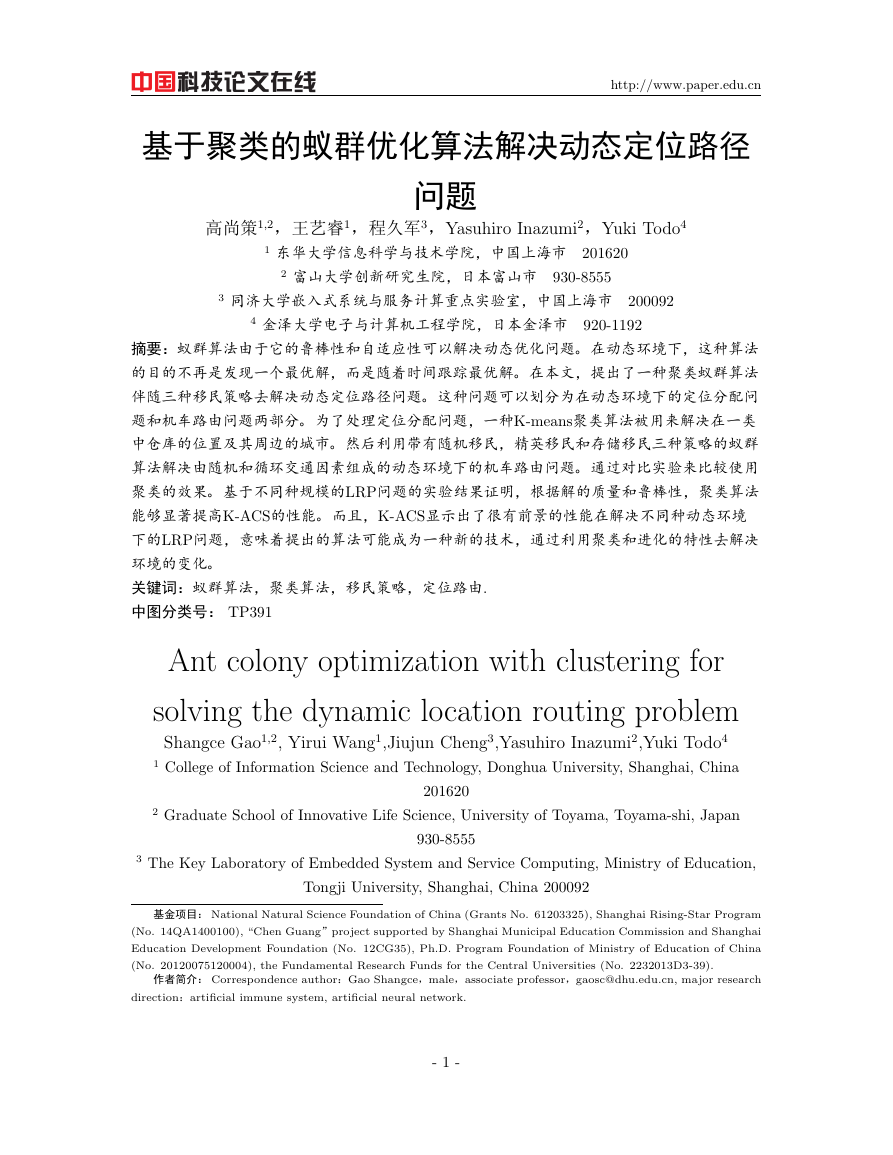
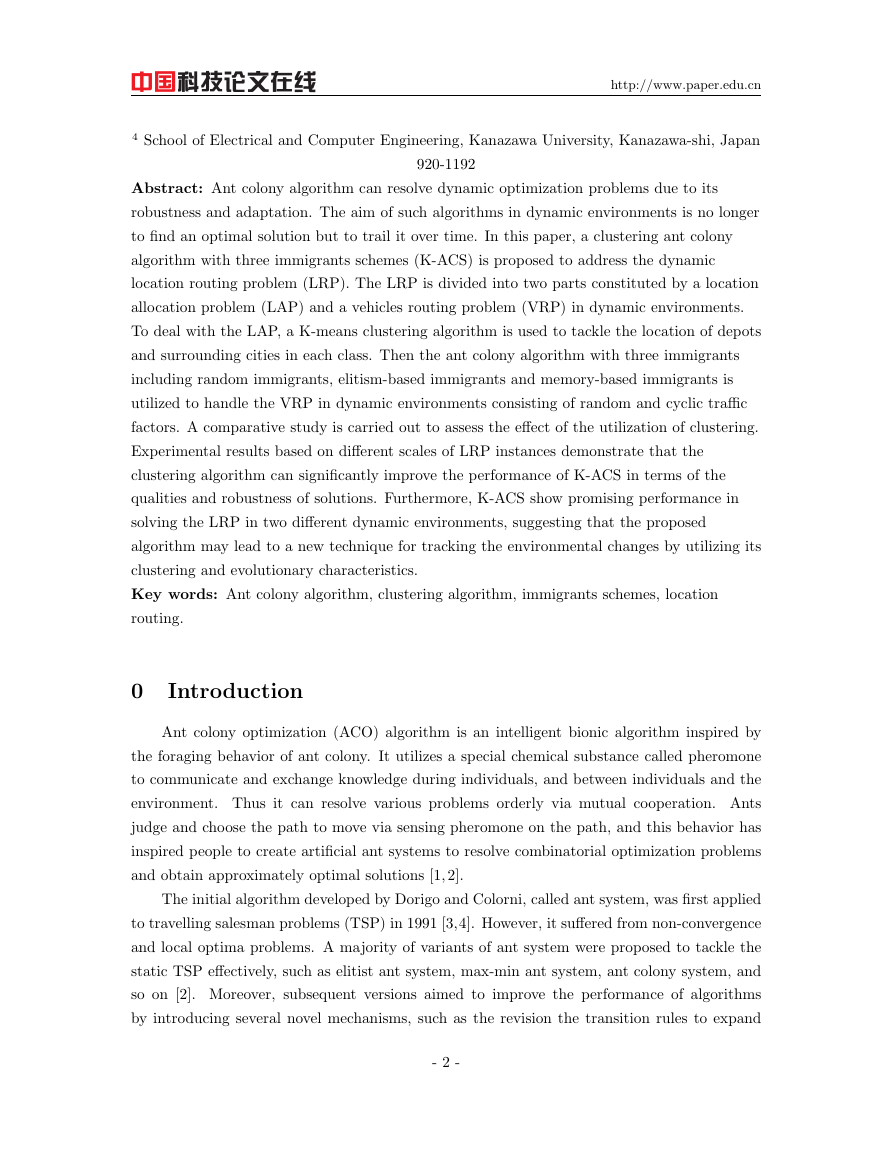
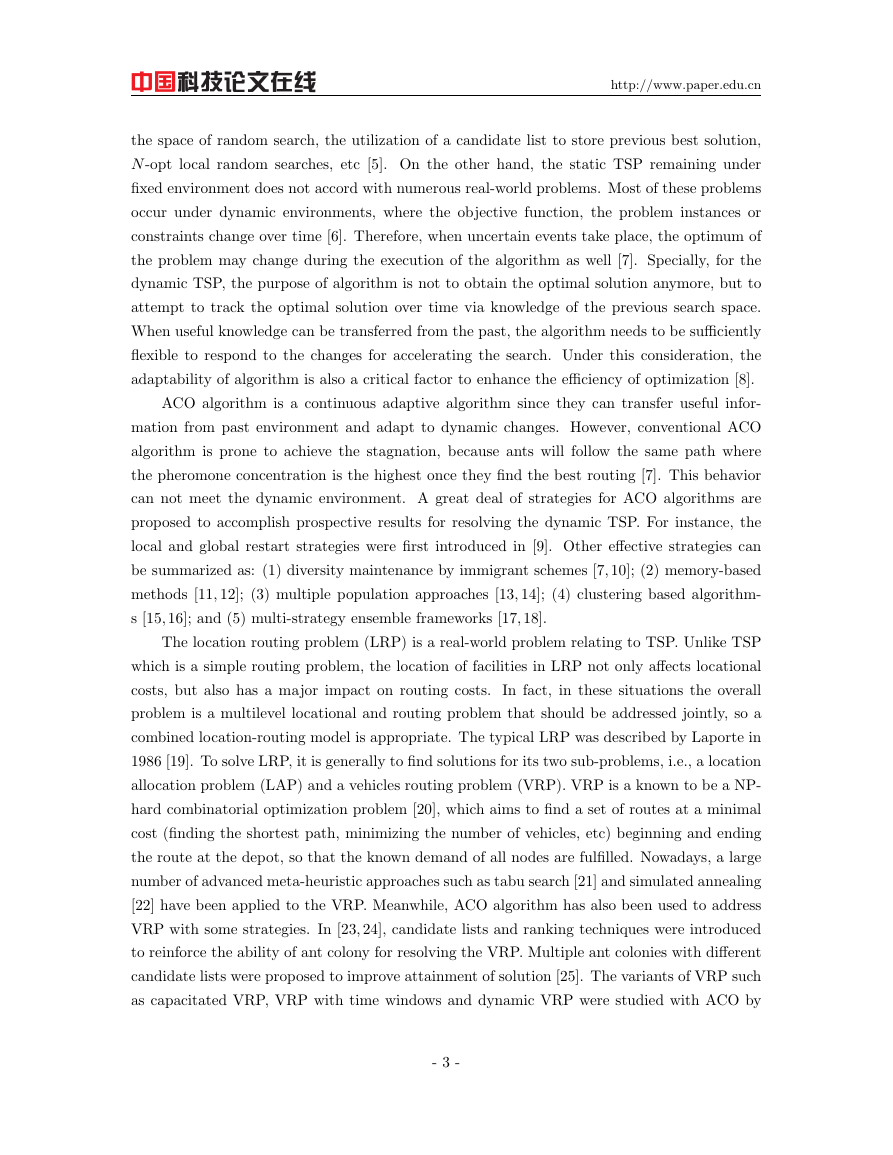
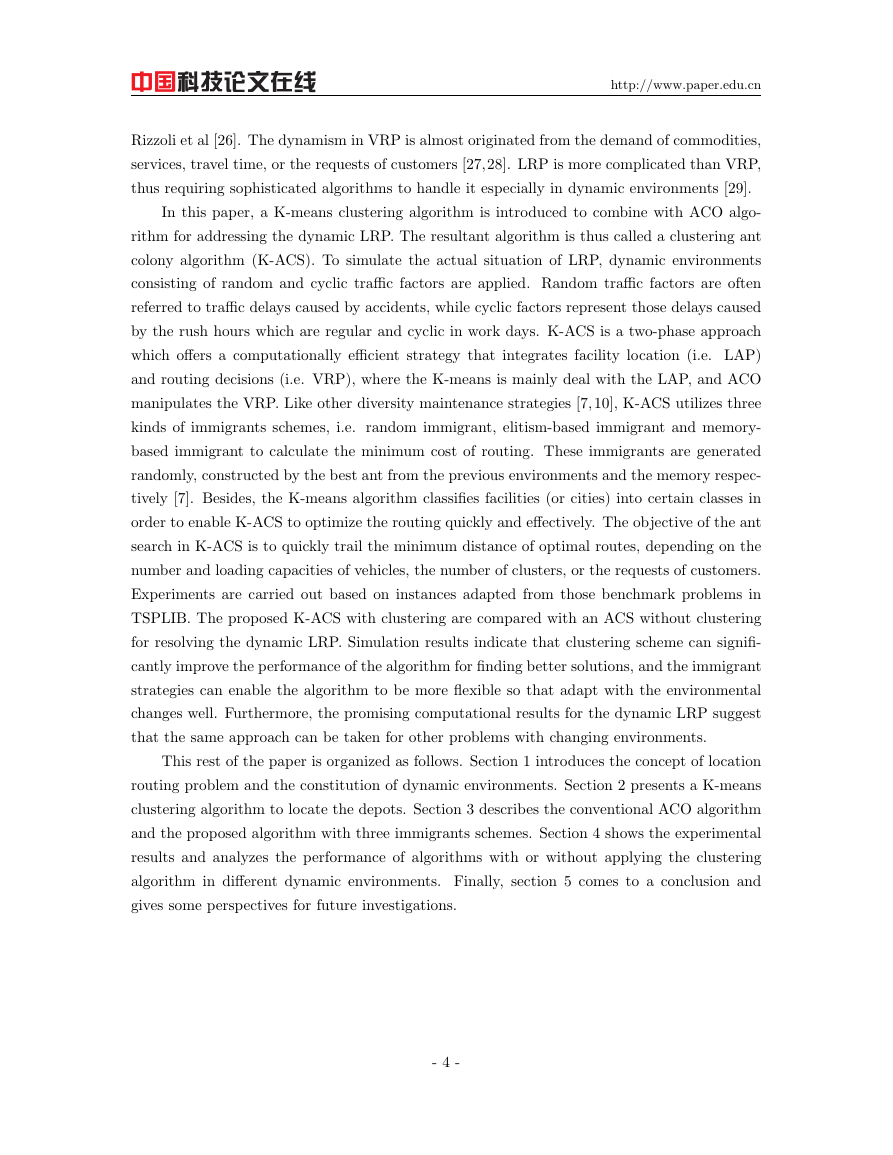
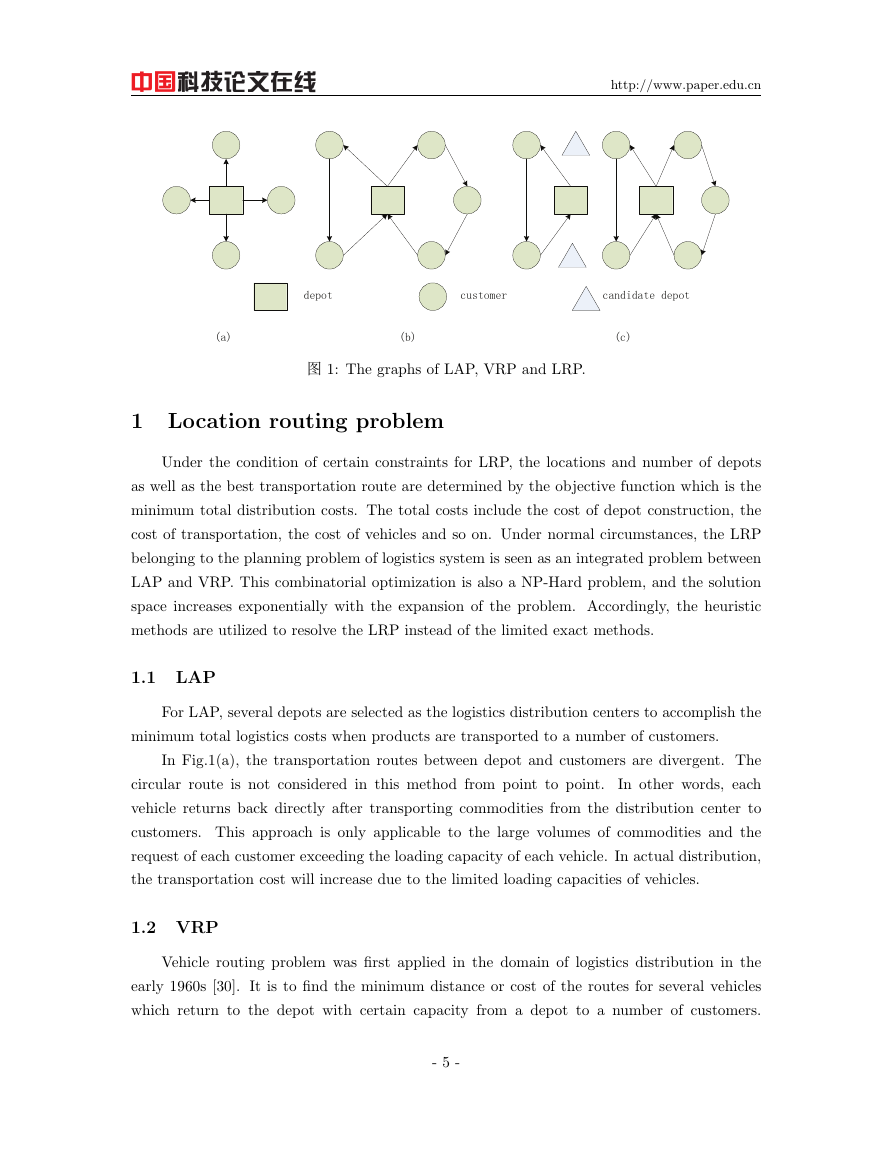


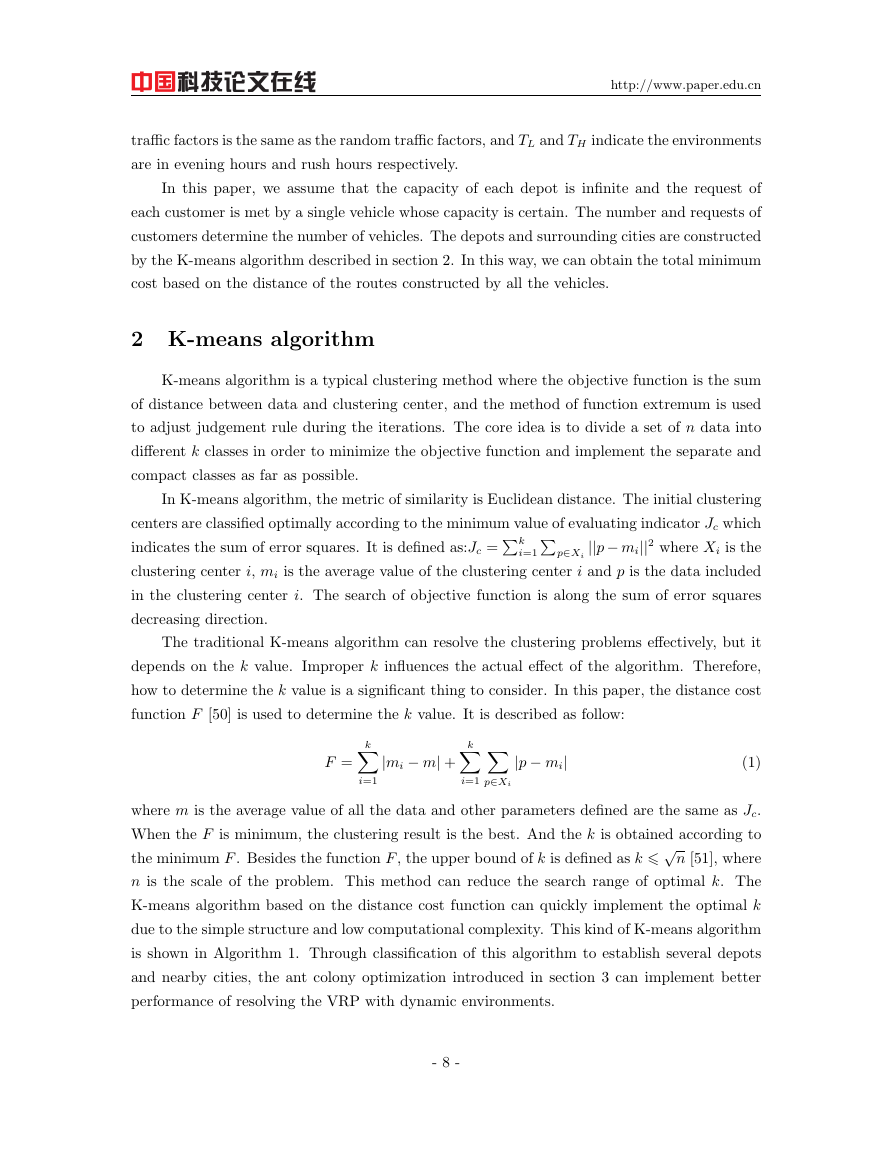








 2023年江西萍乡中考道德与法治真题及答案.doc
2023年江西萍乡中考道德与法治真题及答案.doc 2012年重庆南川中考生物真题及答案.doc
2012年重庆南川中考生物真题及答案.doc 2013年江西师范大学地理学综合及文艺理论基础考研真题.doc
2013年江西师范大学地理学综合及文艺理论基础考研真题.doc 2020年四川甘孜小升初语文真题及答案I卷.doc
2020年四川甘孜小升初语文真题及答案I卷.doc 2020年注册岩土工程师专业基础考试真题及答案.doc
2020年注册岩土工程师专业基础考试真题及答案.doc 2023-2024学年福建省厦门市九年级上学期数学月考试题及答案.doc
2023-2024学年福建省厦门市九年级上学期数学月考试题及答案.doc 2021-2022学年辽宁省沈阳市大东区九年级上学期语文期末试题及答案.doc
2021-2022学年辽宁省沈阳市大东区九年级上学期语文期末试题及答案.doc 2022-2023学年北京东城区初三第一学期物理期末试卷及答案.doc
2022-2023学年北京东城区初三第一学期物理期末试卷及答案.doc 2018上半年江西教师资格初中地理学科知识与教学能力真题及答案.doc
2018上半年江西教师资格初中地理学科知识与教学能力真题及答案.doc 2012年河北国家公务员申论考试真题及答案-省级.doc
2012年河北国家公务员申论考试真题及答案-省级.doc 2020-2021学年江苏省扬州市江都区邵樊片九年级上学期数学第一次质量检测试题及答案.doc
2020-2021学年江苏省扬州市江都区邵樊片九年级上学期数学第一次质量检测试题及答案.doc 2022下半年黑龙江教师资格证中学综合素质真题及答案.doc
2022下半年黑龙江教师资格证中学综合素质真题及答案.doc